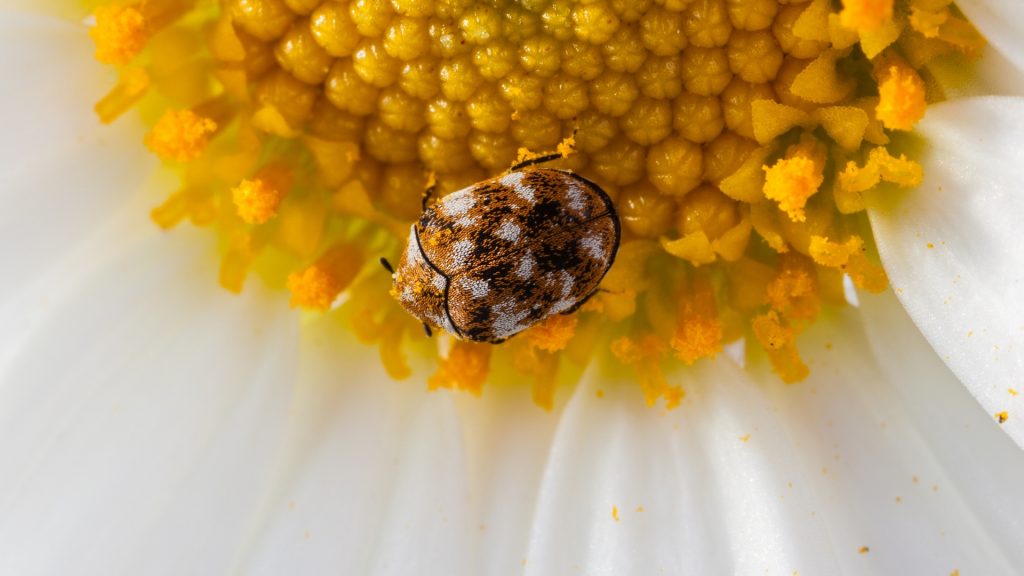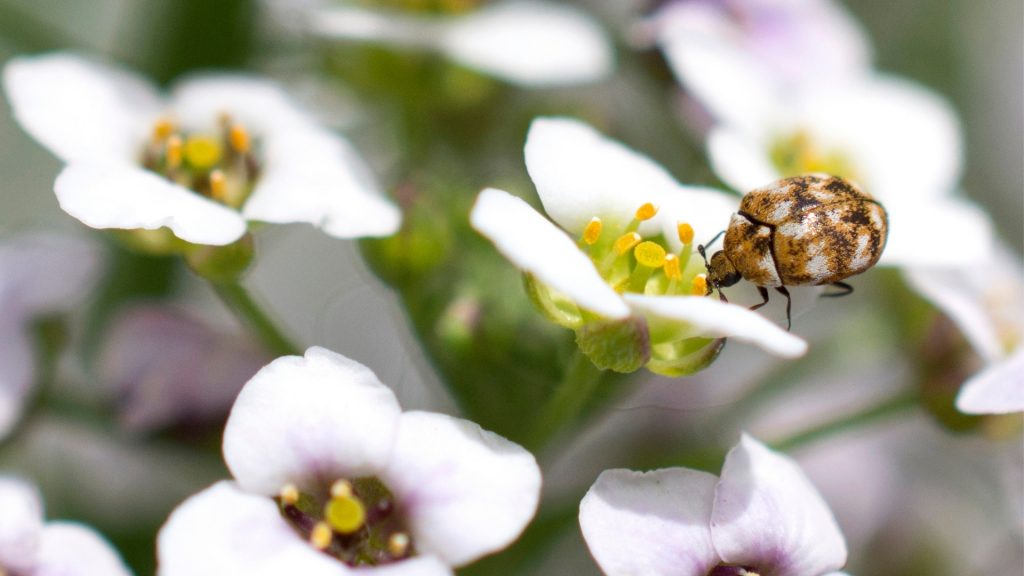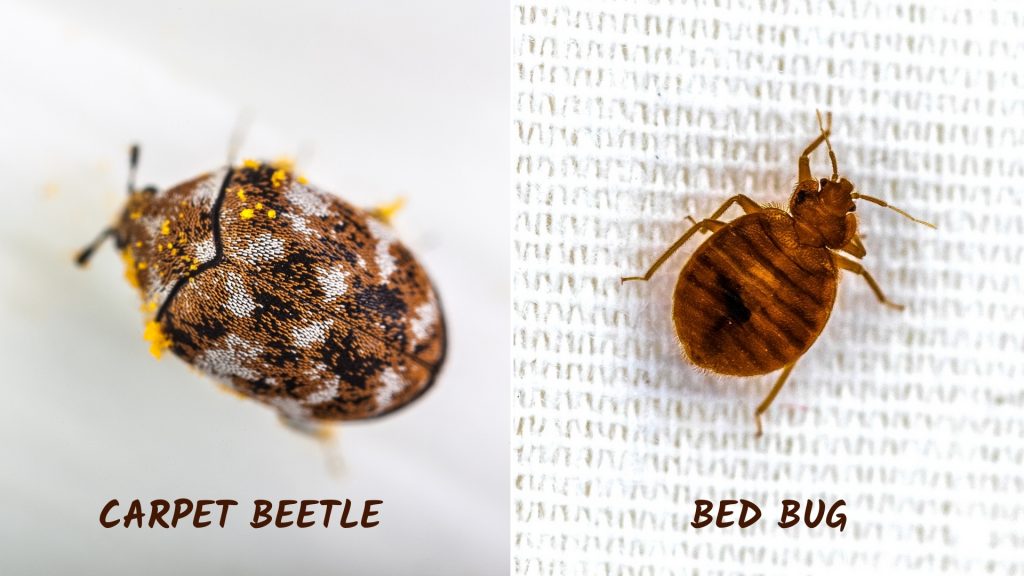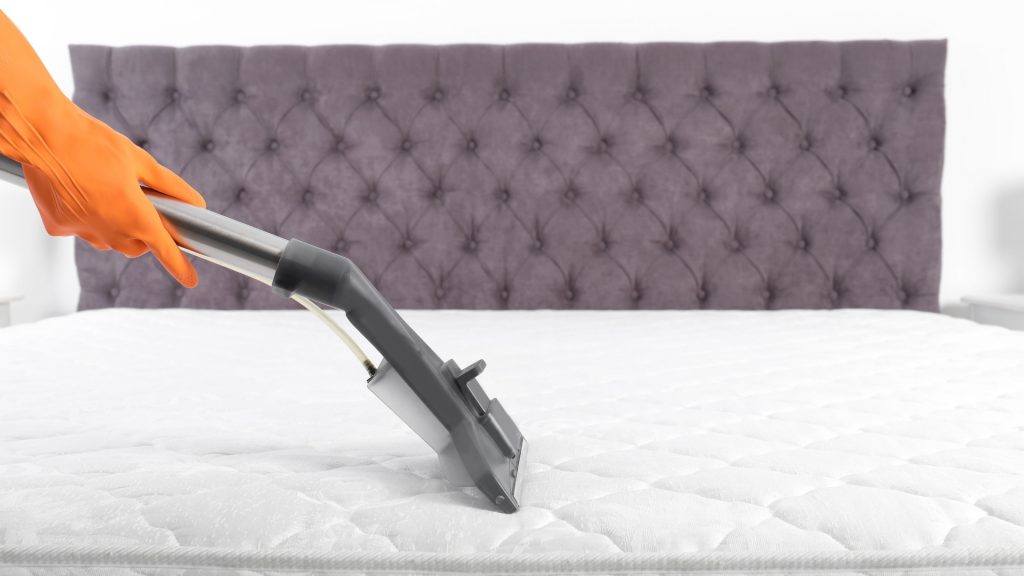Finding a bug in your bed can be disconcerting, and many types of beetles like to live in beds for various reasons. Among these beetles are carpet beetles which feed on natural animal fibers, like those in sheets and wool blankets. How do they get there in the first place, and how do you get rid of them?
Do carpet beetles get in your bed? Carpet beetles can get in your bed and will feed off fibers such as pet hair, wool, silk, and cotton, making the blankets and sheets on your bed a perfect place for carpet beetle larvae to eat. You’ll want to spray non-toxic insecticides and essential oil repellents to get rid of them.
In this article, we’ll discuss how to identify carpet beetles to make it easier for you to recognize them when you see them. Then, we’ll go over some of the habits of carpet beetles and ways that you can repel, kill, and remove them from your home.
What Are Carpet Beetles?

So, what makes carpet beetles different from other bugs, and why do they appear in your home?
Carpet beetles, or dermestids, are one of the most common indoor pests. The name dermestid comes from the Greek word for “skin” and “eat,” since larvae prefer to eat animal skin, fabric fibers, and hair.
So, let’s talk about the specifics of carpet beetles so that you can positively identify them.
What Do Carpet Beetles Look Like?
Carpet beetles are round or oval-shaped with a hard outer shell, and are either black or have a spotted calico pattern with yellow, black, and white scales. The larvae are a yellow-brown color, and they have hundreds of tiny hairs.
They also have long hairs near the end of their bodies, which look like a ponytail.
How Big Are Carpet Beetles?

Carpet beetles are tiny and the adult and larval sizes depend on the type of carpet beetle. Still, no variety will ever get any larger than 1/2 in (1.27 cm) long.
Black carpet beetles are usually 3/16 in (4.76 mm) long at full adult size, but when they are larvae, they can be up to 1/2 in (1.27 cm) long. Varied carpet beetles are more petite than black carpet beetles and are 3/16 in (4.76 mm) to 1/4 in (6.35 mm) long when they are larvae. As adults, they’re 1/8 in (3.18 mm) long.
Where Do Carpet Beetles Come From?
Adult carpet beetles can fly and are attracted to light. Carpet beetles may fly in through a door or unscreened window, and if they find a suitable food source for their larvae, they may lay eggs near that food.
Carpet beetles may also come inside domestic spaces via food, fabric, feathers, or animal hides.
They prefer to lay eggs in small crevices, making beds, rugs, and other areas with pet hair or natural-fiber cloth some of the primary places they colonize.
What Do Carpet Beetles Eat?

Adult carpet beetles only eat pollen, but the larvae have a more diverse diet. They commonly eat natural fibers like wool, cotton, and silk. They also eat dry cereal foods, pet foods, animal hair, leather, dry animal carcasses, and dried flowers.
Because only the larvae eat fibers, adult carpet beetles can’t stay alive in your home for long.
Carpet Beetle vs Bed Bug

So, if carpet beetles live in beds, does that mean that they are bed bugs? The short answer is no.
Carpet beetles are not bed bugs, and they’re not even related. Bed bugs feed on blood, while carpet beetles eat fibers. Bed bugs are also lighter in color, and they don’t have a round shell as carpet beetles do.
There are plenty of differences between carpet beetles and bed bugs. Let’s take a look at the differences so you can tell the difference between them.
Is a Carpet Beetle a Bed Bug?
Although carpet beetles can live in beds, they’re different from bed bugs. The most marked difference between the two is that bed bugs have pointy mouths that bite and suck the blood.
Carpet beetles, however, cannot bite, although their larva may cause an allergic reaction.
Difference Between Carpet Beetle and Bed Bug
| Characteristics | Carpet Beetle | Bed Bug |
| Larvae | Hairy | Smooth and wormlike |
| Length | Between 3 mm (1/8 in) and 5 mm (3/16 in) | 4.5 – 5 mm (3/16 in) |
| Shape | Round, protruding shell with wings | Flat body with ridges and no wings |
| Color | Matte brown, black, or calico | Almost translucent amber brown |
| Signs of Infestation | Shed skins, dead adult beetles by windows, holes in your fabrics | Black smears on your mattress or sheets |
| Food Source | Animal hair, skin, pet food, dried flowers | Blood |
Types of Carpet Beetles
The most common types of carpet beetles are the black carpet beetle and the varied carpet beetle. Varied carpet beetles are round, and have a calico color, while Black carpet beetles have black or dark brown color, and their bodies are much more oval-shaped than varied beetles.
Are Carpet Beetles Harmful?
Even though carpet beetles aren’t blood-suckers like bed bugs, you may still wonder if they are harmful or poisonous.
Carpet beetles are not harmful, although their larvae can cause a minor allergic reaction if they contact human skin. Only some people are allergic to carpet beetle hairs, so you may not even notice the carpet beetles in your bed.
Do Carpet Beetles Bite?
Carpet beetles don’t bite, but they can cause allergic reactions, which are called carpet beetle dermatitis.
People who come into contact with carpet beetle larvae may have small red welts on their legs that look like mosquito bites. Only the immature larvae of carpet beetles cause these welts because larvae have fine hairs that irritate human skin and often cause an allergic reaction.
Do Carpet Beetles Live in Beds?

Finding any bug in your bed is a frightening experience, especially if it seems like the bugs are intentionally setting up camp on your mattress.
Carpet beetles often live in beds. Since they’re attracted to pet hair, dead skin, and natural fibers like wool, they often feed on blankets, sheets, and feather pillows. If you find evidence of carpet beetles, you’ll want to spray a non-toxic insecticide to get rid of them.
Let’s talk more about why carpet beetles might be living in your bed.
Why Are Carpet Beetles in My Bed?
Carpet beetles, like every organism, need to eat. They’re attracted to the smell of animal hair, natural fibers, and dead skin, which makes your bed a prime spot for them. And, because your mattress is thick and private, they can live in your bed undetected for a long time.
What Attracts Carpet Beetles in Your Bed?
If you let your dog or cat sleep with you, large deposits of animal hair in your bed might attract carpet beetles. Wool or silk bedclothes and blankets are also a common food source for them.
If you don’t clean your sheets very often, carpet beetles may also eat dead skin or crumbs left between your sheets.
Signs of Carpet Beetles in Bed?
If you think that you may have carpet beetles in your bed, you should look for:
- Small holes in your bedclothes where carpet beetles have eaten the fabric.
- Hairy larvae
- Shed shells of the beetles or larvae underneath or around your furniture.
Carpet Beetle Eggs in Bed
If you think you may have carpet beetles in your bed, check for eggs in your pillowcases, under your mattress, on your box spring, or between your blankets. Carpet beetle eggs are tiny, ovular, and white. Usually, female carpet beetles will lay 50-100 eggs in one clutch, so you’ll likely see a large cluster of them.
How To Get Rid of Carpet Beetles in Bed?

Getting the carpet beetles to leave your bed is simple. All you have to do is clean your bed area very well and change some of the fibers you keep in your bedroom.
To get rid of carpet beetles, do the following:
- Wash your bedclothes in hot water.
- Gather cotton, silk, felt, feather, and wool items in an airtight container or bag.
- Freeze your fibrous items or wash them in hot water.
- Vacuum your mattress and floors thoroughly, cleaning beneath your bed and other furniture.
- Check the underside of rugs and carpets for larvae and use tape to trap them if you find any.
- Clear your room of spiderwebs and all dead insects, which carpet beetles feed on.
- Vacuum all of your furniture, paying close attention to the undersides of cushions, seams, and creases.
- Vacuum vents to remove lint and larvae.
What Kills Carpet Beetles in Bed?
Removing carpet beetles from your bed can be challenging since you can’t just spray toxic insecticides on your blankets and mattress. Still, there are plenty of ways to kill carpet beetles in your bed.
To kill carpet beetles in your bed, you can use non-toxic insecticides like Green Bean Buddy Bug Killer, essential-oil-based repellents like Mighty Mint Insect and Pest Control, or vinegar.
- 100% Effective All In One Pest Control during a (12)month study
- Proven Through American Academy Entomological (12)month Research...
- Kills All States Of Pests Life Cycle adults, nymphs of bed bugs,...
- Dry Residual Protection successful killing agent during the (12)...
- Non-Toxic, No Odor, Safe & Eco-Friendly – Child safe, pet safe,...
- PET-FRIENDLY & FAMILY-SAFE FORMULA – Mighty Mint is a top pick...
- POWERFUL PLANT-BASED PEST CONTROL – Formulated with...
- EFFECTIVE INDOOR & OUTDOOR USE – Designed for versatile...
- FRESH MINTY SCENT WITH LONG-LASTING EFFECT – Infused with pure...
- READY-TO-USE 16 OZ SPRAY FOR TARGETED APPLICATION – Perfect for...
- LUCY’S NATURAL COMPOSITION - Lucy’s White Vinegar's...
- SPICING UP DIPPING SAUCES - Lucy’s White Vinegar can add a...
- SUBSTITUTE FOR SALT OR BUTTERMILK - Lucy’s White Vinegar can be...
- ALL-PURPOSE CLEANER - Lucy’s White Vinegar is a powerful,...
- 100% FAMILY OWNED, FOUNDED AND OPERATED - Lucy’s was...
There are several other ways to kill carpet beetles, so keep reading to learn how you can eradicate your pests quickly and effectively.
Will Bed Bug Spray Kill Carpet Beetles?
Some general insecticides will kill both bed bugs and carpet beetles, but not all bed bug sprays will kill both. It’s essential to always check your bug spray’s label to ensure that it lists carpet beetles.
Related: Top 6 Natural Bed Bug Sprays
Best Insecticide for Carpet Beetles To Spray On Bed
Eco Defense USDA Biobased Pest Control Spray works for 30 days after spraying your mattress, and it’s perfectly safe for your bed. Within 5 to 10 minutes of spraying, the carpet beetles will either run away from your bed or die, so it’s best to always have a vacuum cleaner on hand when you spray.
- ELIMINATES HOME INVADING PESTS: This bug spray for home works...
- ORGANIC & NATURAL: Made with Natural, Organic, and non-toxic...
- FAST ACTING: Eco Defense is not only Fast Acting but also Long...
- Safe to use all around your home. Eco Defense is a Natural Non...
Best Carpet Beetle Repellents
If you want to keep carpet beetles from coming into your home, you can use several repellents to ward them off. Try these products available on Amazon.com:
- Cedar Sense Cedar Rings. These cedar rings are an easy and natural way to repel carpet beetles. Keep some under your mattress or rugs, in closets, or in drawers to keep carpet beetles at bay.
- Natural Fresh Scent: Enjoy the delightful and refreshing aroma of...
- Premium Quality: Crafted from high-quality, sustainably sourced...
- Perfect Fit: Designed to easily slip onto standard closet...
- Eco-Friendly: A natural and chemical-free way to enhance your...
- Multi-Pack Convenience: Each set includes 30 cedar rings,...
- BRISON Indoor Electronic Pest Repeller. This bionic and ultrasonic repellent is safe for use in your bedroom, and it will not cause a risk for the well-being of your kids or pets.
No products found.
Best Carpet Beetle Natural Sprays
When it comes to bringing insecticides into your home, safety is paramount, which is why all of the repellents and insecticides on this list are safe to use around pets and kids, meaning that they’re also safe to use in your kitchen, bathroom, and bedroom without any toxic fumes or harmful chemicals.
To safely repel carpet beetles, try using these products available on Amazon.com:
- MDX concepts Organic Home Pest Control Spray. Carpet beetles hate strong scents like peppermint oil, so this all-natural spray is an excellent way to keep them from laying eggs in your home.
No products found.
- Wondercide Indoor Pest Control. Wondercide also uses fragrant essential oils to repel and kill carpet beetles. It’s made just for kitchens, which means that it’s food-safe.
- KILLS & REPELS. A preventative and a treatment, this...
- PROTECT YOUR HOME. This versatile bug control spray is also an...
- SAFE AROUND DOGS & CATS WHEN USED AS DIRECTED. This spray is...
- PLANT POWERED AND POWERFULLY EFFECTIVE. Using natural essential...
- EASY-TO-USE. This biopesticide can be sprayed easily around the...
You can also use vinegar spray to repel and kill carpet beetles. Just spray it on your problematic areas and watch the beetles move away!
How To Keep Carpet Beetles Out of Bed?
If you’re struggling to keep carpet beetles out of your bed, try to:
- Wash your sheets and blankets often.
- Use a hypoallergenic mattress cover.
- Use synthetic sheets and blankets instead of cotton, silk, or wool.
- Vacuum the carpet or rugs near your bed regularly.
- Clean all lint, dust, and hair from beneath your bed.
- Remove pet hair from your bed.
- Keep crumbs out of your bed.
Summary
Carpet beetles may be annoying and gross, but they’re relatively harmless, especially when compared to bed bugs. Still, once you know how to identify and eliminate carpet beetles from your bed, you’ll never have to worry about those creepy crawlers again.
Sources
Green, J. (2018). Finding and Removing Variegated Carpet Beetles. Oregon State University Extension Service.
Powell, P. K. Carpet Beetles. West Virginia University, Extension Service.
Green, J. Carpet Beetles. Institute of Agriculture and Natural Resources. Nebraska Extension in Lancaster County.
Jacobs, S. (2017). Carpet Beetle Dermatitis. PennState Extension.
Potter, M. F. Carpet Beetles. College of Agriculture, Food and Environment, University of Kentucky.
- How to Get Rid of Copperheads | Practical Guide - August 27, 2023
- How to Get Rid of Corn Snakes | What Makes Them Aggressive? - August 27, 2023
- How to Get Rid of Alligators | Safety Measures and Removal Methods - July 16, 2023






